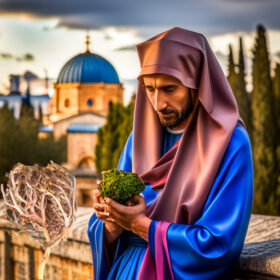ROSE OF JERICHO, Rose of Jericho oil
The flexible wonder of the desert: Rose of Jericho
The Jericho Rose, scientifically known as Anastatica-Hierochuntica, is a wonder of nature that has captivated scientists, nature lovers and cultures for centuries. This intriguing plant, also called the “Revival Plant”, the “Dinosaur Plant”, the “Jericho Rose” and the “Desert Rose”, belongs to the Anastatica family and thrives in arid regions of America, especially in the Judean Desert in Israel, even associated with “Jerusalem”.
At first glance, the Jericho Rose may appear to be an unassuming plant, but its extraordinary hardiness and unique survival strategies make it a true botanical wonder. The nickname “miracle plant” or “revival plant” is fitting for this amazing species, as it has an unparalleled ability to withstand extreme conditions, making it a symbol of hope and renewal.
During periods of prolonged drought or adverse environmental conditions, the Jericho Rose exhibits an extraordinary adaptive response. It will curl up tightly into a ball, similar to a “weed plant” or “dormant plant”, and lose almost all of its moisture content. Its leaves turn brown and become brittle, giving the impression of lifelessness. This state of dormancy allows the plant to maintain its energy and withstand harsh weather, earning it the title “dry weather plant” or “drought resistant plant”.
The appearance of Jericho Rose in its dried state, reminiscent of a prehistoric relic, contributes to its common names, such as “prehistoric plant” and “dinosaur plant”. However, its seemingly lifeless state is only temporary, and the plant has a captivating secret to reveal.
When water becomes available again, whether due to rainfall or deliberate irrigation, the Jericho Rose defies expectations and displays its miraculous ability to “resurrect”. When the water touches their dry form, they slowly unfold the leaves and branches, turning bright green, and seeming to come back to life. This unusual process of resurrection earned it the names “Resurrection Plant” and “Resurrection Plant”, and made it a symbol of hope and perseverance in the face of adversity.
Although the Rose of Jericho is not a true Rose, its tightly bound appearance when grown in full moisture has led to it being commonly referred to as the “Rose of Jericho” or “flower of Jericho”. It is interesting to note that there is another plant called the “False Jericho Rose” due to its visual resemblance to the real Lord Jericho from Jerusalem.
Beyond its amazing ability to survive in difficult conditions, Rose of Jericho captured the curiosity of scientists as “botanical curiosity”. Its ability to withstand extreme desiccation and then flower with access to water has stimulated research into drought tolerance and hydrophobic plants. Understanding the mechanisms behind its resilience may have significant implications for agricultural and horticultural practices, help cultivate crops that can withstand arid conditions and conserve water resources.
Throughout history, the Jericho Rose has had cultural and symbolic value in various societies. Seen as an “ephemeral plant”, it symbolizes the cycle of life, death and rebirth. In traditional medicine, it is believed to have healing properties and is considered an “antioxidant plant”.
While the plant is found primarily in the Judean Desert in Israel, it is also known to thrive in other arid areas, including wadis, earning it the name “wadi plant”. Another common term for Jericho Rose is “thorny moss”.
In conclusion, Rose Jericho, with its many names and captivating characteristics, stands as a testimony to the wonders of nature. From being a “miracle plant” that can rise from apparent death to its symbolic meaning of renewal and hope, this humble “air plant” has left an indelible mark on the world of botany. Its ability to tolerate the harsh environment of the The Judean Desert in Israel near the ancient city of Jericho and other arid regions has earned it the well-deserved title of “Jericho Rose”. As we continue to explore and understand the secrets of this flexible plant, we are reminded of nature’s ingenuity and the wonders that lie hidden in even the most seemingly ordinary organisms.



